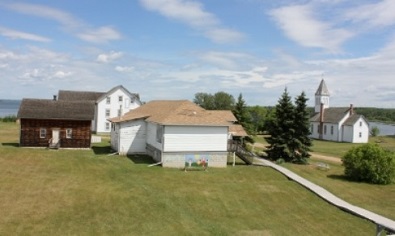Notre Dame des Victoires / Lac La Biche Mission National Historic Site of Canada
Lac la Biche, Alberta

General view looking east
© Lac La Biche Mission Historical Society | Société historique Lac La Biche Mission, Jennifer Mueller, 2015.
Address :
67453 Mission Road, Lac la Biche, Alberta
Recognition Statute:
Historic Sites and Monuments Act (R.S.C., 1985, c. H-4)
Designation Date:
1989-02-24
Dates:
-
1924 to 1947
(Construction)
-
1853 to 1980
(Significant)
Event, Person, Organization:
-
Father René Rémas
(Person)
-
Father Tissot
(Person)
-
Father Maisonneuve
(Person)
-
Father Henri-Joseph Faraud
(Person)
-
Father LeGoff
(Person)
-
Grey Nuns
(Organization)
-
Filles de Jésus
(Organization)
-
Brother Patrick Bowes
(Builder)
-
The Missionary Oblates of Mary Immaculate
(Builder)
-
Cree
(People, group)
-
Métis
(People, group)
Other Name(s):
-
Notre Dame des Victoires / Lac La Biche Mission
(Designation Name)
Research Report Number:
1989-019, 1989-020, 2007-SDC-022
Plaque(s)
Existing plaque: 11 km northwest of Lac La Biche, Lac la Biche, Alberta
Established by the Oblates in 1853 beside the Hudson's Bay Company post, the Mission was relocated to this site in 1855-1856 to serve as the warehouse for Northern Missions. It became the hub of a transportation system which ran overland from St. Boniface to the Mission and on the Athabasca Mackenzie river system to Fort Good Hope. Church, convent and residential school ministered to the needs of the Métis community and the Cree and Dene of the area. The Mission also played a role in aiding the local people to make the transition from a hunting to an agrarian way of life.
*Note: This designation has been identified for review. A review can be triggered for one of the following reasons - outdated language or terminology, absence of a significant layer of history, factual errors, controversial beliefs and behaviour, or significant new knowledge.
Description of Historic Place
Notre Dame des Victoires / Lac La Biche Mission National Historic Site of Canada is located on an isolated flat site surrounded by fields at the southern end of Lac La Biche, 10 kilometres west of the town of Lac La Biche, Alberta. At designation the mission was composed of three principal mission buildings: a rectory, a convent, and a church that is still actively used by the community. There are also several outbuildings related to the farming operations of the mission scattered across the property, including a laundry, grain shed, chicken coop, outhouse and grist mill. Official recognition refers to the main buildings, the outbuildings and the fields that once formed part of the mission operation.
Heritage Value
Notre Dame des Victoires / Lac La Biche Mission was designated a national historic site of Canada in 1989 to commemorate: its role as an Oblate Mission; its place in the development of the fur trade and of transportation and communications in the Canadian West in the last half of the 19th century.
Established in 1853, Notre Dame des Victoires / Lac La Biche Mission became one of the more important western Oblate missions by the 1870s. Originally located near the Hudson’s Bay Company trading post, the mission was relocated in 1855 to its present site. Over the next decade a series of simple log-framed buildings were built, including a church, a rectory, a convent, a residential school and several farm buildings. With the arrival of the Grey Nuns in 1862 and the use of local labour, the mission was self-sufficient and flourishing by 1870, and began serving local Cree and Dene converts, as well as the local Métis population. An industrial school was opened at the mission in 1885, in response to Dominion government policy, and by 1905 the convent building was renovated to house a residential school. Throughout the life of the Mission, most of the original buildings were rebuilt or underwent important renovations, reflecting its historical character as an isolated community where frequent renovations were key to its survival.
Due to its geographical location, Notre Dame des Victoires / Lac La Biche Mission became the hub of an important portage route which ran overland from St. Boniface to the Mission and from the Athabasca-Mackenzie river system to Fort Good Hope. The Mission was used as a “trans-shipment” centre and warehouses were constructed for the storage of goods to be shipped to the missions further north.
Sources: Historic Sites and Monuments Board of Canada, Minutes, February 1989 and December 2007.
Character-Defining Elements
Key elements that contribute to the heritage character of the site include: its location at the hub of an important transhipment route on La Biche lake, in Alberta; its isolated flat setting on the south shore of La Biche lake ; the varied, simple geometric massing, heights, sizes and distinctive profiles of the site’s individual gable-roofed structures, including the church, and the convent; the original placement, design and materials of the doors and windows; the evidence of the evolution of the convent building, including original elements dating from the 1870s, such as the log beams supporting the main floor, some walls and mouldings of the roof structure, as well as the post-1905 additions and alterations; the physical and spatial inter-relationship of the main buildings, outbuildings and the surrounding landscape; the integrity of surviving archaeological remains relating to the mission, features and artifacts in their original placement and extent, including the in situ vestiges of structures including the evidence of two other church structures on the site; viewscapes from the site across La Biche Lake.